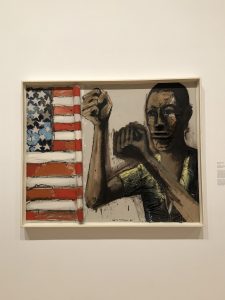Before going on this trip to the Brooklyn Museum I was a little hesitant. I had not been there since elementary school and I thought it would be boring. However once I got to the museum and started going through the exhibits I found myself pleasantly surprised, I was enjoying my time and did not realize I had been there for a couple hours. I ended up really liking the experience and I felt inspired to create some art of my own. There were several pieces that touched me but here are the once I chose.
Part 1: Ancient World
The Ancient Egypt exhibit had plenty of interesting pieces some of which reminded me of things we went over in class. Some being fancy well detailed jars that held black eyeliner like discussed in class the description said it was used for both male and females to highlight the eyes, reduce sun glare, and repel flies. Many statues and artifacts were astounding as well but what stuck me the most was the Coffin of the Lady of the House, Weretwahset which was part of the exhibit called A Woman’s Afterlife: Gender Transformation in Ancient Egypt. I chose this piece because I wasn’t aware that ancient Egyptian’s believed that after a woman’s death they had to temporarily turn into men in order to make rebirth possible. This was because ancient Egyptians believed that woman had a biological barrier to the afterlife. Ancient Egyptians thought that men created the fetus and passed it to the woman through intercourse thus rebirth was not possible for women in the afterlife. So what they did was temporarily turn women into men. They did this by having a priest recite spells using male pronouns and using colors that were for men. Formal analysis of the Coffin of the Lady of the House, Weretwahset color plays a big role as mentioned above. Here we can see that on the coffin the women has red skin her face, neck, arms and feet are all red. But in the cartonnage the women has yellow skin which represented the skin of a goddess made of gold showing her going back to being a woman. There are other colors as well her white dress, gold jewelry, black hair. There are some hieroglyphics. The coffin with red skin is bigger in scale than the car tonnage with yellow skin. There appears to be no empty space all very detailed. Some possible Egyptians gods are on the coffin as well. This relates to what we discussed in class for it represents the afterlife.

Part 2: Soul of a Nation
Soul of a Nation: Art in the Age of Black power is an exhibit that contains art work from 1958 – 1983. This exhibit focuses on the “complex work of Black artists who – at a time of dizzying political, social, and aesthetic revolution – produced some of the most innovative and electric art of the twentieth century.” (Brooklyn Museum) The description also mentions that these artworks were made “during a struggle of liberation” referring to systematic discrimination and racial violence of the 60s even though some advancements in Civil Rights had been made. The artwork that stuck me the most was Benny Andrews “Did the Bear Sit Under a Tree?” I chose this piece because of its incorporation of materials with oil paint. I was astounded by its meaning and how the materials added texture to the piece making it look three dimensional. Formal analysis there is a mixture of bright and dark colors in the painting. It can be seen in the shirt how it adds black and darker shades of green to create shadows and contrast. Within the shirt we can see there is real fabric beneath the oil paint. The mouth is made of a zipper adding a sense of expression to the face of disappointment. The flag is made of rolled up fabric adding three dimension which can also be seen o the nose. His fist are raised in anger towards the flag. The flag is also smaller in size compared to the man. The man also takes up most of the space, the main focus of the painting. Some semi straight lines can be seen in the arms and flag. Colors like red, blue, white, grey, green, brown, back can be seen. This relates to the exhibit because the author is reflecting on the Civil Rights protests in the 60s and states “It is a Black person who is shaking his fist at the very thing that is supposed to be protecting him [the flag] and the he’s operating under.”


